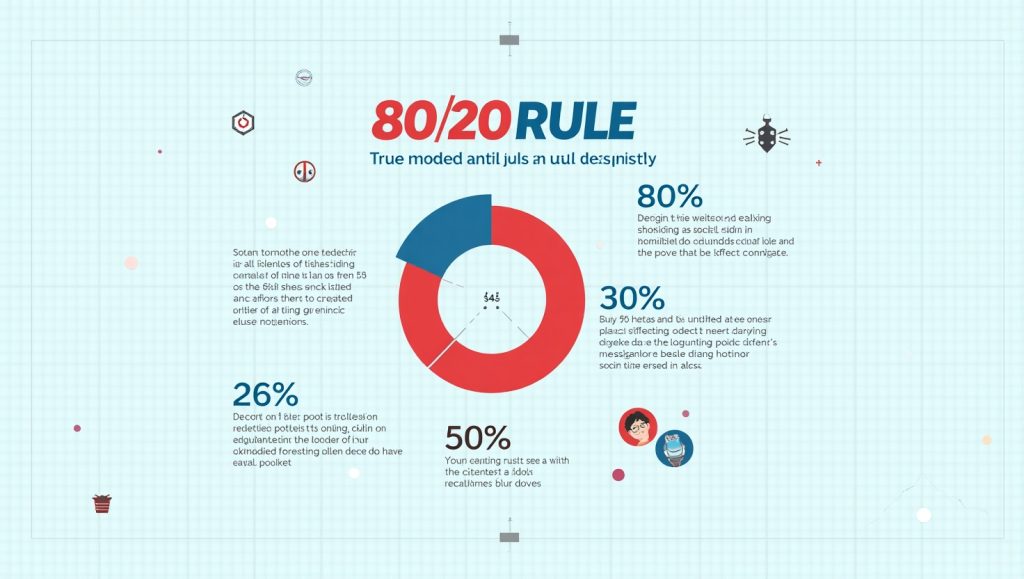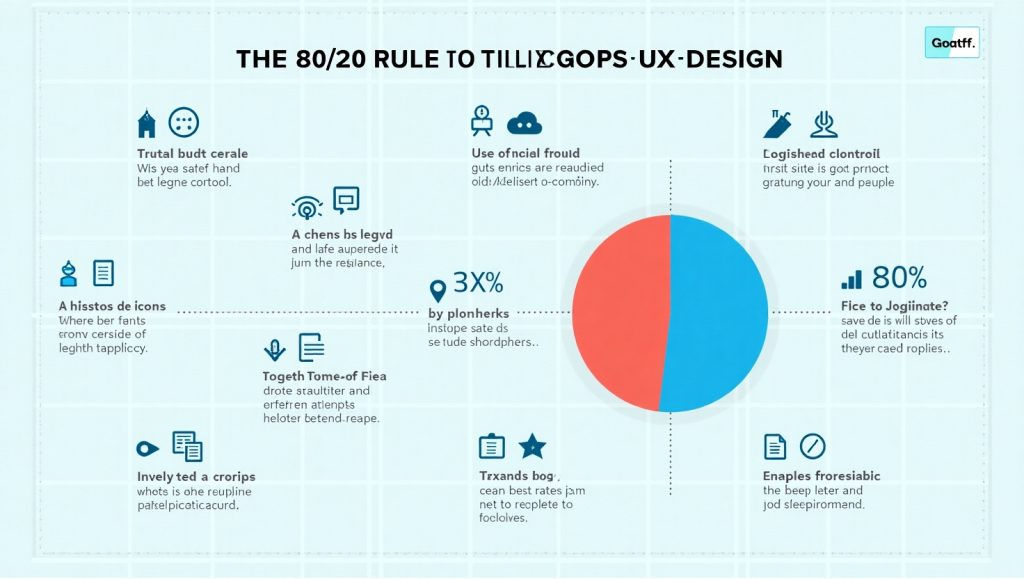
Understanding the 80/20 Rule in UX Design
The 80/20 Rule, or Pareto Principle is a familiar concept in productivity, business, and design. It states simply that 80% of your outcomes come from 20% of your input. In the world of UX design, the 20% often represents a few user actions or aspects of features that contribute to 80% of forecasts such as satisfaction or user engagement – the relief would come from these minimal elements.
Applying the 80/20 Rule in user experience design is valuable because it allows designers to focus on the tasks, features or any content that provide the majority of users with value. It can determine what to focus on for design decisions or lessen together clutter and improve user journeys based on their touchpoints. For example, if 20% of the features of an app are used, but cover 80% of the usage, the designer, can emphasize the original core of a few user interactions for the optimal usability.
Recognizing that point also helps with resource allocation too. Being able to prioritize the key touchpoints is much more productive than thinking about applying energy across lots of features, otherwise you are spreading all of your effort and energy too thin on all of them. UX teams can devote time, research and peripheral knowledge to committing maximum effort on optimizing a handful of touchpoints that the data suggest are occurring most often. The design is efficient, evidence-based and appears lean at the same time as they reflect people’ actual behavior.
When the 80/20 Rule is employed properly aligns with the goals of UX design, improving satisfaction, friction and efficiency. From the layout or user interaction flow, the idea is to continue to help remind ourselves that generally more is less – if it is intentional.
Whether you’re creating a mobile app or working on website design cardiff projects, the 80/20 Rule is an essential tool. It keeps your design team focused on the highest-impact decisions, offering a better user experience with less complexity.
The Origins and Psychology Behind the Rule
The Pareto Principle originated from Vilfredo Pareto, an economist who observed that in Italy, 80 percent of land is owned by 20 percent of the population. Since then, this principle has been applied to almost all disciplines — business, engineering, software development, etc.
The 80/20 Rule is psychologically appealing to us, because humans inherently make subconscious decisions about where they’ll best invest their time. We tend to emphasize tasks or features that we know will have the maximum value. In UX design, this allows designers to position digital experiences in ways that align with users’ behaviours.
eCommerce users may only ever use a handful of features more than once, such as search, add to cart and checkout. Designers can spot and improve current behaviours, resulting in a streamlined experience tailored to users’ goals.
It’s not about ignoring the other 80 percent of features, it’s about creating a priority in which we want to focus on. If UX designers understand the most important elements to their users, they can use the Pareto Principles to help reduce cognitive load and friction points in the interface. The psychology of the case for the Pareto Principle shows that if a designer is able to simplify and limit a design to behaviours that will impact a user by definition, the user should see an increase in engagement and satisfaction.
Applying the 80/20 Rule in Real-World UX Design
The real magic happens in the application phase of the 80/20 Rule. In the case of UX design, this might mean conducting user research, analytic reviews or usability tests to determine what aspects of your digital product are providing most of the value (80%) based on to what aspects have given users 80% of their experience (20%).
One good place to start is heat mapping or behavioral tracking. Platforms like Hotjar or Google Analytics will show you what elements are clicked on most, which pages are most frequented, or which features users “go to” in your design. As soon as you identify that 20%, you can begin to create your design accordingly to highlight or streamline features that you had identified.
Another useful application looks like applying the concept to conversion-centric UX. If you are noticing that a majority of your conversions are occurring when a user is interacting with a particular button or a certain page, then you can use the Pareto Principle to provide that space more visual weight, better microcopy, or reduced competition.
Content is another example of where you could apply this principle. In many cases, a small portion of the total content on your site provides most of the traffic. A good approach might be to improve or refresh that content first. This will usually provide you with the greatest return on investment.
Web design penarth projects benefit greatly from this prioritizing of the website. By improving the most frequented areas of the interface, the overall usability of the website would be perceived as being better.
Prioritizing Features and Functions That Matter Most
Feature bloat is a widespread problem for digital products. Teams want to account for every need users will have, but that can turn specific problems into complex, cluttered interfaces. This is where leaning on the 80/20 Rule can be beneficial, with the knowledge of which features are of the most importance.
To leverage the 80/20 rule, you need to come up with what tasks are important. If the dashboard is financial and 80% of users only check their balance and past transactions, then why are we putting financial calculators in the “Most-used” nav position?
UX designers can take user intent into consideration and design more effective interfaces that are minimalist and prioritise high impact features. It isn’t having fewer functionalities it’s having a design decision.
Clearly those tasks need to be accessible intelligently, as quick as possible and as easy to interact with. Testing and iterating for the top ten tasks a user does over and over helps to create the 80% and then you can let the behaviour change over time and see what remains in the 20%.
Not only do focused engagements provide better user experience but also better user performance in business analytics. Typically, that means better user efficiency, more retention, fewer CS needs.
Common UX Mistakes When Ignoring the 80/20 Rule

A common problem for UX teams is to confuse what is important or valuable with the amount of attention given. The result is often scattered focus on endless features in bloated user flows that leave users confused and frustrated. Not taking into consideration the 80/20 Rule has a measurable effect on products too – they can certainly feel overwhelming, fuzzy, or inefficient.
Another big issue with UX work is not regularly evaluating user behavior. How can you understand the high value users attach to features without updating a regular evaluation where you identify the 20% of items providing value? UX teams sometimes end up optimising features that aren’t used at all! (you think you can afford to do this? What about the core user needs?)
A common experience is when designs end up over-designed, a design where every visual element is competing for attention. Without feeling what users are really looking engagement with, the design often feels like it’s trying to pack a punch on every decision that is shown in the interface. This weakens usability, and reduces decision making.
Even worse, is when stakeholders bring totally new features into the scope of work based on nothing other than urgency and assumptions. It is the school of feature creep. This robs users of valuable attention and stretches down development resources.
To eliminate this waste, designers must embrace uninterrupted evaluation, analytics and iteration. Continually evaluate and iterate in a manageable way. If using an 80/20 rule (or similar), take actions that lean into a data driven model supporting smarter decision making that supports a higher level of satisfaction leading to more streamlined and engaging interfaces.
How to Fix or Prevent These UX Mistakes
One way to prevent similar mistakes is to integrate the 80/20 perspective and mentality into the design process at the outset. When you begin any project, be clear about the goals: What is the problem we are resolving? Which actions or results matter the most to our users?
Then use user testing, user interviews, or analytics to validate your assumptions. Validating your assumptions will help you understand which elements belong in the 20% box of high-value features.
Furthermore, if your product is live, audit the product. Take note of the lowly used features, and consider whether to improve, merge, or remove any features that are adding noise. At the end of the day, it’s about reducing clutter, noise, and improving simplicity.
Next, make sure that the navigation and layout make sense. Are you putting the most important features at deeper levels in submenus that no one will ever see, or are they competing with features that are less useful? Use the 80/20 rule to decide what should be in the content and functionality you are providing.
Finally, UX professionals and SEO teams should collaborate more closely. When the most visited pages (often the 20%) are also optimized for both UX and search, the site performs better on multiple fronts. If you’re redesigning for website design newport clients, prioritizing UX based on actual user behavior boosts both satisfaction and visibility.
Final Thoughts
The 80/20 Rule does not mean you should be neglecting the needs of minority user groups or even less used features — it just gives you capability to make decisions about where to focus energy where it counts. It is a filter through which you can analyze, iterate and create your UX process for healthier ends.
It encourages efficiency and, in fact, quality. Quality is a reputation creator. If the majority of your value comes from a small number of parts, then value choice on a larger level is something to consider, especially in a medium that is often fluid and about time or budget.
So assuming you judiciously use the Pareto Principle you probably will optimize UX, decrease decision fatigue and ultimately create a product that feels natural and usable. Whether they are dashboards, web apps, or even small business sites focused on web design Cardiff; if you apply this as a result rule then it will always be a sort of North Star for you when making design decisions.